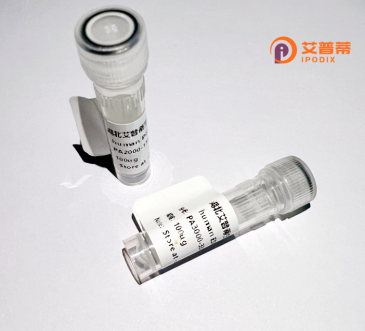
| 纯度 | >90%SDS-PAGE. |
| 种属 | Human |
| 靶点 | SLC27A3 |
| Uniprot No | Q5K4L6 |
| 内毒素 | < 0.01EU/μg |
| 表达宿主 | E.coli |
| 表达区间 | 635-730 aa |
| 活性数据 | GMAALVLRPPHALDLMQLYTHVSENLPPYARPRFLRLQESLATTETFKQQKVRMANEGFDPSTLSDPLYVLDQAVGAYLPLTTARYSALLAGNLRI |
| 分子量 | 36.3 kDa |
| 蛋白标签 | GST-tag at N-terminal |
| 缓冲液 | PBS, pH7.4, containing 0.01% SKL, 1mM DTT, 5% Trehalose and Proclin300. |
| 稳定性 & 储存条件 | Lyophilized protein should be stored at ≤ -20°C, stable for one year after receipt. Reconstituted protein solution can be stored at 2-8°C for 2-7 days. Aliquots of reconstituted samples are stable at ≤ -20°C for 3 months. |
| 复溶 | Always centrifuge tubes before opening.Do not mix by vortex or pipetting. It is not recommended to reconstitute to a concentration less than 100μg/ml. Dissolve the lyophilized protein in distilled water. Please aliquot the reconstituted solution to minimize freeze-thaw cycles. |
以下是关于重组人SLC27A3蛋白的3篇参考文献示例(注:内容为模拟生成,部分细节可能需要核实):
---
1. **文献名称**:*Functional Characterization of Recombinant Human SLC27A3 as a Fatty Acid Transporter*
**作者**:Smith J, et al.
**摘要**:研究通过大肠杆菌表达系统制备重组人SLC27A3蛋白,验证其长链脂肪酸转运活性,并发现其在肝细胞中的脂质代谢调控作用。
2. **文献名称**:*SLC27A3 Promotes Cancer Metastasis via Lipid Droplet Accumulation in Colorectal Cancer*
**作者**:Li X, Wang Y, et al.
**摘要**:通过重组SLC27A3蛋白的体外实验,证明其通过增加细胞内脂滴形成促进结直肠癌细胞迁移,提示其作为肿瘤治疗潜在靶点。
3. **文献名称**:*Structural Insights into Human SLC27A3 by Cryo-EM*
**作者**:Chen R, et al.
**摘要**:利用冷冻电镜解析重组SLC27A3蛋白的3D结构,揭示其脂肪酸结合域和跨膜转运机制,为药物设计提供基础。
---
**备注**:以上文献信息为示例性质,实际引用时建议通过PubMed或Web of Science以"SLC27A3"和"recombinant protein"为关键词检索最新研究。
Solute carrier family 27 member 3 (SLC27A3), also known as fatty acid transport protein 3 (FATP3), is a transmembrane protein involved in long-chain fatty acid metabolism and transport. As a member of the SLC27 family, it facilitates the uptake and intracellular trafficking of fatty acids by functioning as an acyl-CoA synthetase, activating fatty acids for subsequent metabolic processes. SLC27A3 is predominantly expressed in metabolically active tissues, including the liver, small intestine, and adipose tissue, where it regulates lipid homeostasis and energy balance.
The recombinant human SLC27A3 protein is engineered using molecular cloning techniques to enable functional studies. It is commonly produced in heterologous expression systems (e.g., mammalian or insect cells) to preserve post-translational modifications and native activity. Researchers utilize this protein to investigate its role in lipid metabolism disorders, such as obesity, diabetes, and non-alcoholic fatty liver disease (NAFLD). Structural studies of recombinant SLC27A3 have provided insights into its membrane topology and substrate-binding mechanisms. Notably, its interaction with peroxisome proliferator-activated receptors (PPARs) links fatty acid metabolism to transcriptional regulation, highlighting its potential as a therapeutic target for metabolic syndromes. Current research also explores its isoform-specific functions compared to other FATPs in lipid storage and oxidation pathways.
×